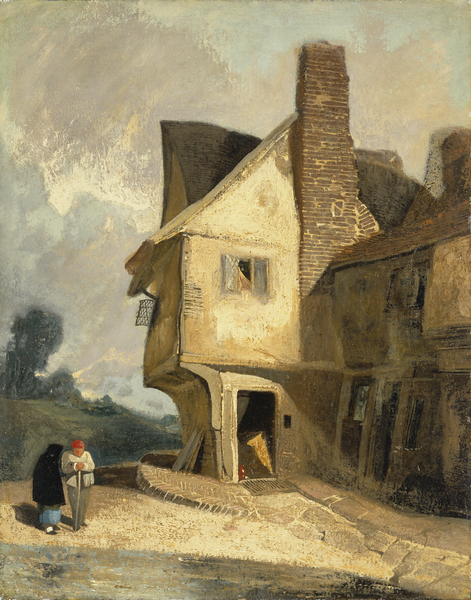An Old House at St Albans
John Sell Cotman 16/05/1782 - 24/07/1842
Summary
A view of a timber-framed house and adjoining cottages with a lane running along the front of them and two figures standing outside. The house and cottages are on the right of the composition and appear to be in a state of decay. The house is seen at an angle to reveal a gable end and part of its facade in shadow; the upper storey overhangs the ground floor, which is smaller to accommodate the pavement, laid in a herringbone design, that runs around the front of the house; the lattice-pattern, leaded windows in the upper storey are open, as is the door in the gable end of the house with a mat laid outside; on the same side, a brick chimney runs up the exterior of the house and adjoining cottage. The cottages are in shadow. The figures stand in the lane as it curves around the buildings: the figure on the left, in profile to the right, wears a black shawl drawn over her head and blue skirt, and the figure to the right, forward-facing, with head bowed and both hands resting on the top of a cane, wears a jacket and trousers with a red hat. On the far side of the lane is a grassy bank with trees.
Display Label
Gallery text panel Expressing Passions Romanticism in Focus In 1772, Sir Joshua Reynolds told the Royal Academy that perfect works of art 'cannot express the passions'. Harmony, uniformity and restraint were preferred and there was little room for emotional content. This stress on classical qualities characterised the 1700s, echoing the stability and confidence of Georgian society. Artists of the early 1800s redressed the balance, placing human experience above artistic conventions and injecting greater personal vision into their work. This was largely in response to a more turbulent age of revolution, war and political reform. Uncertainty and rebellion were echoed in art through subjects representing disturbance and in an emphasis on individuality and imagination. The term Romanticism defines these developments. Although there was never an organised movement, there are distinctive hallmarks of Romantic art. These include a more direct response to nature and a new stress on colour as a means of expression. As artists became increasingly guided by their intuition, they grew more independent of patrons' demands: artistic freedom and experiment entered a new age.
Object Name
An Old House at St Albans
Creators Name
Date Created
1806 (circa)
Dimensions
Canvas: 42cm x 33.2cm
Frame: 57cm x 47cm
accession number
1981.297
Place of creation
England
Support
millboard, laid on panel (mahogany)
Medium
oil paint
Legal
© Manchester Art Gallery

